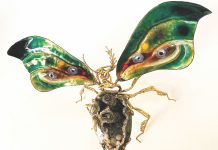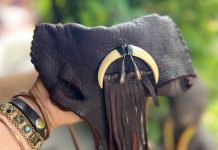Local artists Mandy Brasa and Isabelle Alessandra shine with their abstract designs.
By Sharon Stello
Unlike artwork that attempts to closely mimic people or scenes as they appear in real life, abstract paintings rely on the creativity of both the artist and the beholder, who may interpret the shapes on the canvas in a much different way than the painter intended, drawing their own unique conclusions from the same piece. Local artists Mandy Brasa and Isabelle Alessandra each add their own style to the abstract approach.
Bold and Bright
Abstract expressionist Mandy Brasa, who opened an eponymous gallery in town in 2020, grew up in East Germany and remembers the Berlin Wall coming down at age 12. No doubt those early experiences affect her artwork today, if only on a subconscious level.
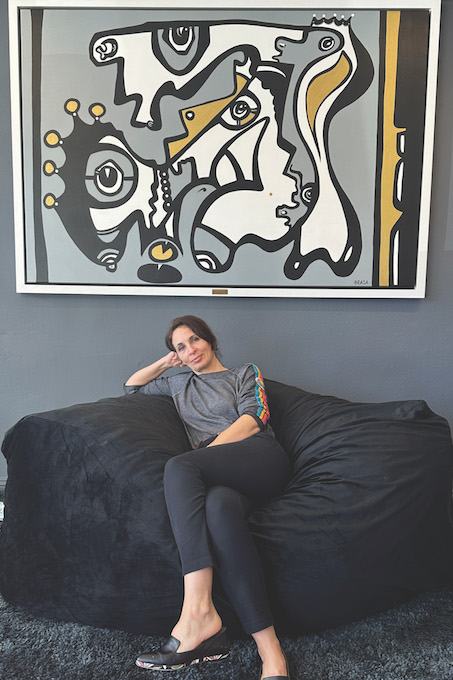
She eventually moved to California after meeting her future partner while on vacation in Santa Cruz and they settled in a small mountain town near Yosemite National Park, surrounded by natural beauty. When she picked up a paintbrush, her initial pieces were centered around animals and landscapes, but she began experimenting with an abstract style shortly after visiting Laguna.
Having previously worked in the hospitality industry, she tapped into her creative side upon connecting with another artist and painting with her a decade ago. Despite little exposure to the art world—and with no formal training—her raw talent flourished, especially as she started painting on larger canvases.
“I feel that not having a formal education in art allows me to create in a way that is uninfluenced by learned techniques and has made it easier for me to find my own unique style,” Brasa says.
The Laguna resident is most inspired by the freedom of beginning an art piece without knowing ahead of time what she will be creating. “It was when I decided to not use the conscious mind and allow a different kind of content and expression to materialize that I found my inner voice and my deepest self-expression,” she says.
Brasa appreciates abstract painting because it’s more liberating. “For me there are no rules and no mistakes,” she says.

For each piece she works on, Brasa might first sketch some line work then adds color based on the form, making adjustments as her creation takes shape. “I can physically feel when a piece works and has a correct vibration, almost like doing architectural design work—all components have to be in balance,” she says. “Occasionally, I will start with a general idea and then let go of the need to create the image, going with the flow to capture a deeper emotional representation.”
Brasa tends to paint in bright, bold colors with strong shapes that flow together. “I have thought about this and it seems that growing up in East Germany, where there was a predominance of drab colors, I might be reacting to that formative influence by trying to bring more color into the world,” Brasa shares.
She primarily uses acrylic paint and freehand brushwork on canvas, but sometimes paints on found objects like sculptures, store mannequins or even couches. “While painting in the gallery, I accidentally spilled some paint on our gallery sofa,” she recalls. “… It was too much to clean up, then [I] decided to keep adding paint. I never thought it would be something that people would want to purchase—only … a gallery novelty, but people seem to love them and I’m currently working on No. 4 in the Brasa Art Couch series.”
Brasa says, of all her work, her favorite piece is most often “the latest one I’m working on.”
Brasa Gallery
490 S. Coast Highway, Ste. 1
949-204-7370; mandybrasa.com
Emotive Expression
Isabelle Alessandra ran a successful consulting company that provided strategic advice and training to education and business leaders. But it was the words of her 96-year-old mother during her final hours in hospice that made Alessandra leave all that behind to become a full-time artist. Now, Alessandra, a Newport Beach resident who paints in the abstract style, exhibits at Laguna’s Festival of Arts, Sandstone Gallery and more.
So what did her mother say? Alessandra shares those powerful words here: “I have one important regret to share with you, and it’s not about what I did with my life, it’s about what I didn’t do,” her mother told her. “… I always found an excuse not to fully pursue my gifts as an artist: work, then family, then caring for your dad, then finally losing my eyesight. … [There were] always reasons that put my desire to create on the back burner.
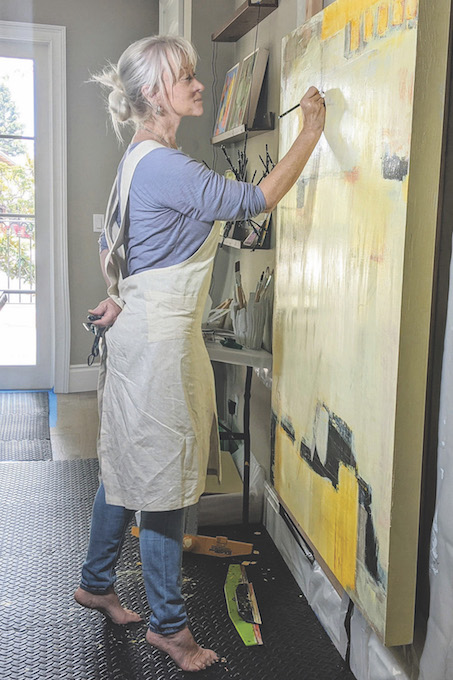
“You have the same gift I had, and I’ve watched you shelve it just like I did. So, after 96 years on earth, here is my best advice for you, right now—use your gift, develop your talent and work full time to let the world know what you can do.”
Alessandra took that message to heart. “Exactly one year after my mother passed, I closed the doors to my company and began painting every day. My work as an artist is a life force that absolutely lights me up, and it’s a cherished legacy from my mother.”
Her work is inspired by what’s around her. “Because the idea of ‘feeling’ my work is important to me, my palette is often inspired by the music I’m playing and, although it isn’t necessarily intentional, my surroundings also influence what happens on my boards,” she says.
The artist, who grew up playing in the foothills of the Canadian Rocky Mountains, tends to incorporate many colors found in nature in her art. “Inspiration can also come from seeing different kinds of art, from talking and laughing with friends, from when it’s raining or the way the sun hits the sand. It’s endless.”
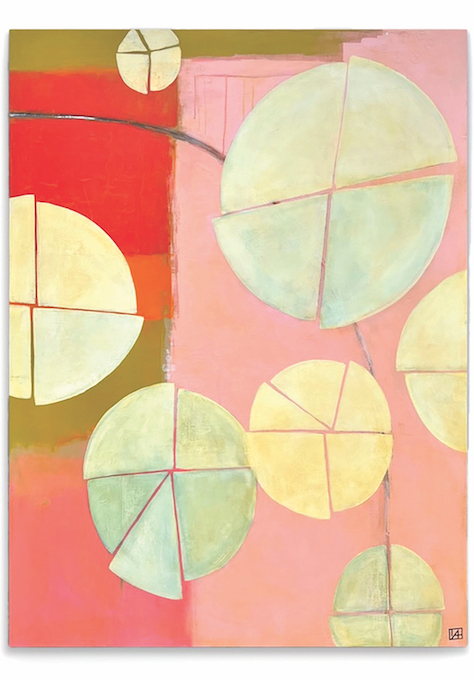
Alessandra views abstract work as “a full mind-body experience.” “For me, art that represents or looks like something familiar, implies how or what the artist—and the viewers—should see and even feel,” she explains. “My own abstract art is a visual expression of emotion using color and form. It’s not that I don’t deeply admire representational art, because I do—it’s more that my own connection to the ideas and feelings in abstract work stretches me in new and unknown directions every time I create a painting. I love that.”
She builds layers and layers of acrylic paint on birch wood panels, then scratches, etches and sands back into those layers to reveal what she calls “the history of the painting.”
When starting a piece, she likes to “paint boldly and a little out of control” then get more intentional about composition. “It becomes a sort of conversation between me and the work,” she says.
Alessandra creates artwork specifically for Sandstone Gallery; in May, a large collection will be featured on the gallery’s lower floor. And her current show at The Ritz-Carlton, Laguna Niguel will run until at least May 1.
Isabelle Alessandra



